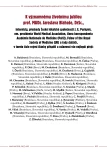ECG markers in patients with hypertrophic cardiomyopathy
Authors:
K. Hudecová 1; I. Šimková 2; M. Bernadič 1
Authors‘ workplace:
Ústav patologickej fyziológie Lekárskej fakulty UK Bratislava, Slovenská republika, prednosta doc. MUDr. Marián Bernadič, CSc., mim. prof.
1; Kardiologická klinika Slovenskej zdravotníckej univerzity a Národného ústavu srdcových a cievnych chorôb Bratislava, Slovenská republika, prednosta prof. MUDr. Róbert Hatala, CSc.
2
Published in:
Vnitř Lék 2010; 56(7): 669-675
Category:
80th Birthday - Jaroslava Blahoše, MD, DrSc.
Overview
Background:
Hypertrophic cardiomyopathy (HCM) is an autosomal dominant inherited disease of the heart muscle whose main characteristic is unexplained hypertrophy of the left ventricle and/or right ventricle. It is considered to be the most common genetically determined cardiovascular disease with the prevalence in the population approximately 1 to 500 inhabitants. The disease is associated with severe complications such as heart failure, arrhythmias and sudden cardiac death (SCD). Nowadays the aim of intensive clinical research is to judge the contribution of noninvasive methods in the risk stratification of HCM patients. Abnormal electrocardiogram occurs in 75–95 % and it often presents the first point for HCM suspicion although it is nonspecific.
Aim:
The aim of our study was to evaluate the electrocardiographic (standard 12-lead) and certain echocardiographic markers in patients with recurrent syncope of unknown origin in comparison with patients without these episodes.
Patients and methods:
42 patients (17 men a 25 women) with verified HCM diagnosis underwent extensive clinical, standard 12-lead electrocardiographic and echocardiographic testing to compare these parameters in the subgroup of patients with syncope (n = 17) of unknown origin and patients without syncope (n = 23).
Results:
As for the electrocardiographic signs we found that more than one half of patients had positive Sokolow-Lyon index (55.6%), prolonged QTc interval (63.2%). Depression of ST segment was present in 60.5%. We also found positive correlation between prolonged QTc interval and maximal left ventricle thickness. We observed that patients with syncope had statistically significantly left ventricle end‑diasotlic diameter in comparison with patients without syncope.
Conclusion:
Standard electrocardiography represents a “gold standard” in the diagnostics of HCM patients. We found positive correlation between prolonged QTc interval and maximal left ventricle thickness. Patients with syncope had statistically significantly smaller left ventricle end‑diastolic diameter in comparison with patients without syncope.
Key words:
hypertrophic cardiomyopathy – ECG – echocardiography – syncope – diagnostics
Sources
1. Maron BJ, McKenna WJ, Danielson GK et al. American College of Cardiology/European Society of Cardiology Clinical expert consensus document on hypertrophic cardiomyopathy. A report of the American College of Cardiology foundation task force on clinical expert consensus documents and the European Society of Cardiology committee for practise guidelines. Eur Heart J 2003; 24: 1965–1991.
2. Ho CY, Seidman CE. A contemporary approach to hypertrophic cardiomyopathy. Circulation 2006; 113: 858–862.
3. Kaludercic N, Reggiani C, Paolocci N. Genes, geography an geometry the “critical mass” in hypertrophic cardiomyopathy. J Mol Diagn 2009; 11: 12–16.
4. Ommen SR, Gersh BJ. Sudden cardiac death risk in hypertrophic cardiomyopathy. Eur Heart J 2009; 30: 2558–2559.
5. Elliott PM, Poloniecki J, Dickie S et al. Sudden death in hypertrophic cardiomyopathy: identification of high risk patients. J Am Coll Cardiol 2000; 36: 2212–2218.
6. Maron BJ. Hypertrophic cardiomyopathy: a systematic Review. JAMA 2002; 287: 1308–1320.
7. Hudecová K, Šimková I, Gardlík R et al. Genetic screening of patients with hypertrophic cardiomyopathy – a new diagnostic strategy in risk stratification? Bratisl Lek Listy 2009; 110: 85–92.
8. Tendera M, Polonski L, Wodniecki J et al. Evolution of the electrocardiographic changes in patients with hypertrophic cardiomyopathy. Clin Cardiol 1991; 14: 891–896.
9. Mattos BP, Torres MA, Freitas VC. Diagnostic evaluation of hypertrophic cardiomyopathy in its clinical and preclinical phases. Arq Bras Cardiol 2008; 91: 51–62.
10. Haghjoo M, Faghfurian B, Taherpour Met al. Predictors of syncope in patients with hypertrophic cardiomyopathy. Pacing Clin Electrophysiol 2009; 32: 642–647.
11. Nienaber CA, Hiller S, Spielmann R et al. Syncope in hypertrophic cardiomyopathy: multivariate analysis of prognostic determinants. J Am Coll Cardiol 1990; 15: 948–955.
12. Schiavone WA, Maloney JD, Lever HM et al. Electrophysiologic studies of patients with hypertrophic cardiomyopathy presenting with syncope of undetermined etiology. Pacing Clin Electrophysiol 1986; 9: 476–481.
13. Dritsas A, Sbarouni E, Gilligan D et al. QT-interval abnormalities in hypertrophic cardiomyopathy. Clin Cardiol 1992; 15: 739–742.
14. Barletta G, Lazzeri C, Franchi F et al. Hypertrophic cardiomyopathy: electrical abnormalities detected by the extended-length ECG and their relation to syncope. Int J Cardiol 2004; 97: 43–48.
15. Yi G, Elliott P, McKenna WJ et al. QT dispersion and risk factors for sudden death in patients with hypertrophic cardiomyopathy. Am J Cardiol 1998; 82: 1514–1519.
16. Göktekin O, Ritsushi K, Matsumoto Ket al. The relationship between QT dispersion and risk factors of sudden death in hypertrophic cardiomyopathy. Anadolu Kardiyol Derg 2002; 2: 226–230.
17. Östman-Smith I, Wisten A, Nylander E et al. Electrocardiographic amplitudes: a new risk factor for sudden death in hypertrophic cariomyopathy. Eur Heart J 201; 31: 439–449.
18. Haghjoo M, Mohammadzadeh S, Taherpour M et al. ST segment depression as a risk factor in hypertrophic caardiomyopathy. Europace 2009; 11: 643–649.
Labels
Diabetology Endocrinology Internal medicineArticle was published in
Internal Medicine

2010 Issue 7
Most read in this issue
- Laboratory diagnostics and endocrinology
- Parvovirus B19 infection – the cause of severe anaemia after renal transplantation
- The influence of testosterone on cardiovascular disease in men
- Chronic pancreatitis and the skeleton
